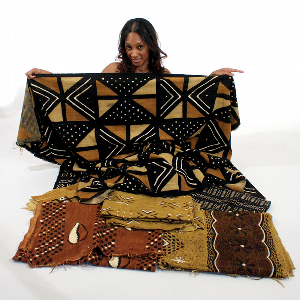
Kuba cloth is just starting to become popular in the United States. Using the leaves of the raffia tree, the Kuba people of the Congo first hand cut, and then weave the strips of leaf to make pieces of fabric, called raffia cloth. There are several different sub groups of the Kuba people. Each group has different and unique ways to make the fabric. Some make it thicker, longer, shorter, or with different patches. Each patch is symbolic and many times a piece has many different meanings. When Kuba cloth originated there were probably no patches used, but as the cloth is brittle it is quite likely that the patches were used to repair the frequent tears. Later each patch developed a meaning, many patterns are uniquely arranged to tell a story.
The art of making Kuba cloth is very time consuming and can take several days to form a small piece. The men first gather the leaves of the raffia tree and then dye it using mud, indigo or substances from the camwood tree. They then rub the raffia fibers in their hands to soften it and make it easier for weaving. After they've completed the base cloth the women embroider it. They do this by pulling a few threads of the raffia fibers, inserting them into a needle running the needle through the cloth until the fibers show up on the opposite end. They then take a knife and cut off the top of the fibers, leaving only a little bit showing. Doing this hundreds of times forms a design. The designs are seldom planned out ahead of time, and most of the embroidery is done by memory.
The Kuba people, who developed this and many other fabrics were very resistant to using European cloth; and for many years seldom used machine-made fabrics. When researching this and other cloths that the Kuba people developed, it is not hard to understand why they resisted the change so much. Each fabric, each pattern, and each design in traditional Kuba fabrics has great meaning. On the basis of what a person wore; you could interpret much about them. Social status age, marital status, and a person's character were just a few of the things a piece of cloth symbolized to these people.
To find a huge selection of kuba cloth and to pick your own piece just click here.
 USD
USD  GBP
GBP  CAD
CAD  AUD
AUD 